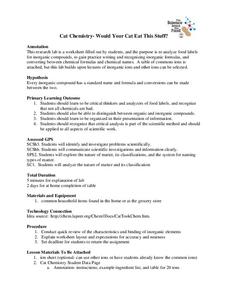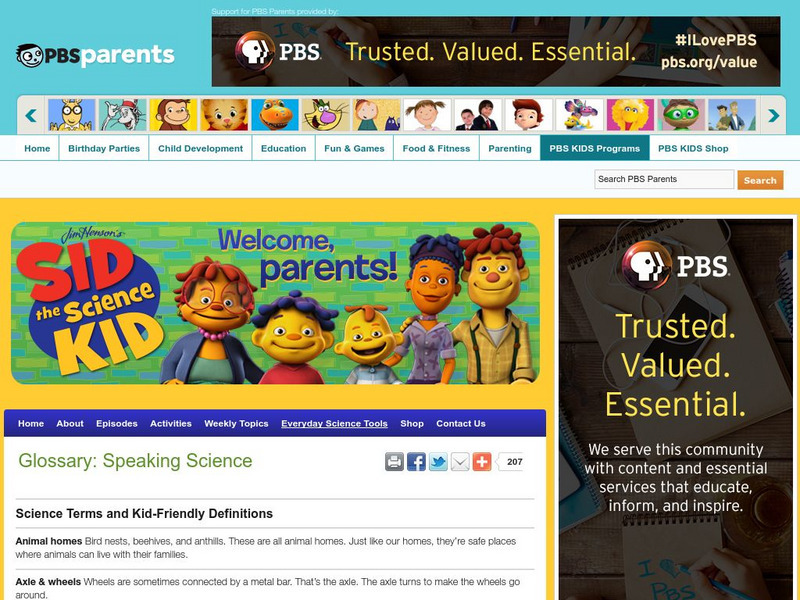National Institute of Open Schooling
Colloids
Classes explore colloids through readings and questions in lesson 10 in a series of 36. They learn everything from methods of preparation and properties to how to classify colloids. They finish the lesson by seeing how to apply...
National Math + Science Initative
Introduction to Decimals
Three activities make up an introductory lesson designed to create a strong foundation in comparing fractions to decimals and exploring and building decimal models. Pupils brainstorm and complete a Venn diagram to show how decimals and...
University of Georgia
Would Your Cat Eat This Stuff?
Processed foods use inorganic compounds for flavoring and preservation. This take-home laboratory challenges scholars to find 20 different compounds identified on the labels of foods to list on their data collection sheet. The activity...
Chymist
Batteries
Young scientists study the construction of a battery through experimentation. They engage in five experiments which combine to create a thorough study of the history of batteries beginning with a model of the first battery.
Science Struck
Science Struck: Examples of Chemical Changes in Everyday Life
This resource lists the different types of chemical reactions and gives examples of chemical changes that are seen in everyday life.
Science Struck
Science Struck: Examples of Chemistry in Everyday Life
Gives examples of chemical interactions occurring in the human body, in the world around us, in foods, and in products we use.
Science Struck
Science Struck: Uses of Titanium in Everyday Life
Learn about the properties of titanium and the many ways we use it in our daily lives, in medicine, in industry, and in monuments.
Science Struck
Science Struck: Examples of Pulleys in Daily Life
Learn how pulleys work and their many uses in everyday life, industry, recreation, and other activities. Includes many pictures of pulleys and pulley systems.
Science Struck
Science Struck: 10 Nasa Inventions You Might Be Using Every Day
Many things invented by NASA are used in everyday life. Some of the most widely used inventions are described here.
Science Struck
Science Struck: Chemical Reactions in Everyday Life
Provides some common examples of chemical reactions, e.g., in respiration, rusting, and photosynthesis.
Science Struck
Science Struck: Carbon Uses in Everyday Life
Learn about the properties and uses of the element carbon.
PBS
Pbs Kids: Sid the Science Kid: Glossary: Speaking Science
A glossary of science terms, including terms for life, earth, and physical science.
Science Struck
Science Struck: Plastic Wars: Thermoplastics vs. Thermosets
Explains what thermoplastics and thermosets are, their properties, and their advantages and disadvantages. Provides lots of examples for each of how they are used in everyday life.
Science Struck
Science Struck: Uses of Silicone Grease
Silicone grease has many uses in everyday life. Learn what it is and how it is used in industry, in a chemical laboratory, and by consumers.
National High Magnetic Field Laboratory
Magnet Academy: Timeline of Electricity and Magnetism: 1900 1909
Albert Einstein publishes his special theory of relativity and his theory on the quantum nature of light, which he identified as both a particle and a wave. With ever new appliances, electricity begins to transform everyday life.
Science Struck
Science Struck: Exothermic Reaction Examples
Explains what an exothermic chemical reaction and is and gives examples seen in everyday life.
Science Struck
Science Struck: Iron: Uses of Iron
Learn about the many important ways that humans use iron.
Khan Academy
Khan Academy: Get Started With Algorithms!
What is an algorithm? It's a sequence of steps that you follow to solve a problem. In everyday life, you might have an algorithm for hanging up your laundry, efficiently going through a shopping list, or finding an empty parking space in...







